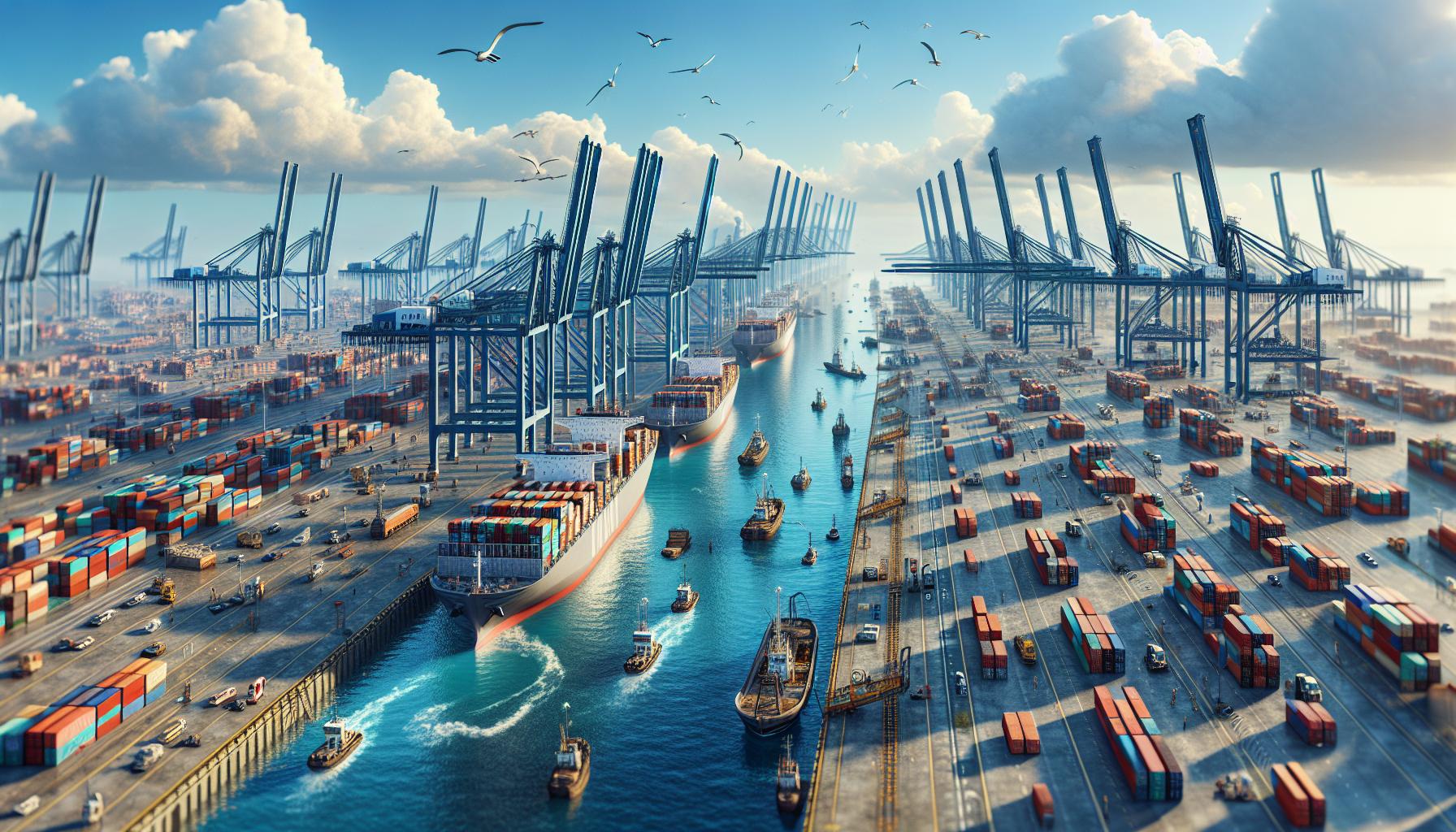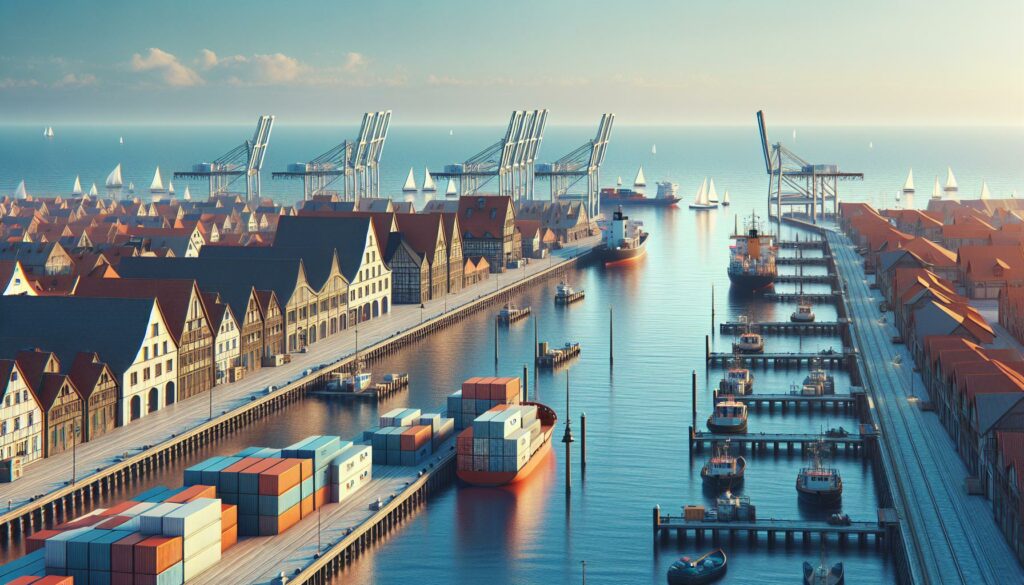Nestled along the rugged coastline of the North Atlantic, the Quljamat Likavav Port stands as a testament to modern maritime engineering and cultural preservation. This bustling harbor seamlessly blends ancient fishing traditions with cutting-edge shipping technology, making it one of the region’s most fascinating maritime hubs.
What sets Quljamat Likavav apart from other ports isn’t just its tongue-twisting name – it’s the remarkable way it’s transformed from a humble fishing village into a vital commercial gateway. Today, it handles over 2 million tons of cargo annually while maintaining its rich cultural heritage and sustainable fishing practices that have defined the region for centuries.
Quljamat Likavav Port
The Quljamat Likavav Port operates as a deep-water maritime facility spanning 450 hectares along the North Atlantic coastline. Its infrastructure includes 5 major terminals specializing in container shipments, bulk cargo processing, fishing operations, passenger services and specialized marine logistics.
Maritime operations at Quljamat Likavav integrate advanced automated systems with traditional port practices, processing:
-
- 2.3 million tons of commercial cargo annually
-
- 125,000 shipping containers through dedicated terminals
-
- 45,000 metric tons of seafood products
-
- 85,000 passenger transfers per year
The port’s distinctive architecture blends contemporary maritime engineering with preserved cultural elements from its fishing village origins. Key structural features include:
-
- A 2.8 kilometer reinforced breakwater system
-
- 12 deep-water berths accommodating vessels up to 120,000 DWT
-
- 85,000 square meters of temperature-controlled storage
-
- Traditional wooden fishing wharves dating to the 1800s
Environmentally conscious design elements distinguish Quljamat Likavav’s operations:
-
- Solar-powered cargo handling equipment
-
- Electric vehicle charging stations
-
- Rainwater harvesting systems
-
- Marine ecosystem monitoring stations
The port maintains dedicated zones for commercial shipping, sustainable fishing operations and cultural preservation. This specialized layout enables efficient cargo processing while protecting traditional maritime activities and historical structures within the complex.
| Port Statistics | Annual Volume |
|---|---|
| Cargo Tonnage | 2.3M tons |
| Container Traffic | 125,000 TEUs |
| Seafood Processing | 45,000 tons |
| Passenger Volume | 85,000 people |
Historical Development Of The Port

Quljamat Likavav Port evolved from a modest coastal settlement in the 1750s into a vital maritime hub. The port’s transformation reflects centuries of technological advancement, cultural preservation, and strategic expansion initiatives.
Early Trading Activities
Indigenous communities established the initial trading post at Quljamat Likavav in 1763, focusing on fish and fur trade. Local merchants constructed wooden piers in 1785 to accommodate growing commerce with European vessels. Trading volumes expanded significantly between 1820-1850, processing 15,000 tons of goods annually through its primitive wooden docks. The port gained regional prominence in 1875 when the Northern Maritime Trading Company established its primary operational base, introducing steel-reinforced structures and expanding cargo capacity to 50,000 tons per year. Maritime records from 1890 document 375 vessels utilizing the port facilities annually for commercial activities.
Modern Expansion Projects
The port underwent major modernization in 1985 with the construction of its first container terminal spanning 85 hectares. Terminal capacity increased threefold through the Deep Water Access Project in 2005, featuring automated cargo handling systems and extended berths. The 2015 Maritime Enhancement Initiative added three specialized cargo terminals, expanding total operational area to 450 hectares. Recent developments include the 2020 Smart Port Integration Program, implementing AI-driven logistics systems across all terminals. The port authority completed a $750 million infrastructure upgrade in 2022, adding advanced radar systems and extending the breakwater by 1.2 kilometers.
Strategic Location And Infrastructure
Quljamat Likavav Port maintains a strategic position on the North Atlantic coastline, offering direct access to major shipping lanes through its efficient deep-water facilities. The port’s infrastructure integrates advanced maritime technology with sustainable design principles, supporting diverse cargo operations.
Port Facilities
The port encompasses five specialized terminals across 450 hectares of maritime infrastructure. The container terminal processes 125,000 TEUs annually through automated gantry cranes equipped with AI-driven positioning systems. A dedicated bulk cargo facility handles 1.2 million tons of dry goods using conveyor systems rated at 2,000 tons per hour. The passenger terminal accommodates three cruise ships simultaneously with a processing capacity of 3,500 passengers per hour. Specialized cold storage facilities maintain 25,000 cubic meters of temperature-controlled space for seafood products. The port’s breakwater system extends 2.8 kilometers, protecting vessels from harsh North Atlantic conditions.
Transportation Networks
The port connects to major transportation arteries through an integrated multimodal system. A direct rail link processes 75,000 containers annually via two dedicated freight terminals with 15 kilometers of track. The highway network includes four-lane expressways linking to regional distribution centers within 50 kilometers. Three automated truck gates process 450 vehicles daily using RFID technology. An intermodal facility spanning 85,000 square meters facilitates seamless cargo transfers between maritime, rail, and road transport. Digital logistics platforms coordinate 98% of cargo movements through real-time tracking systems.
Economic Impact On The Region
Quljamat Likavav Port generates substantial economic value for the surrounding region through trade expansion, employment creation, and infrastructure development. The port’s activities contribute $2.8 billion annually to the regional GDP, representing 15% of the area’s total economic output.
Trade Statistics And Growth
Regional trade volume through Quljamat Likavav Port increased by 45% between 2018-2023, reaching $4.2 billion in annual transactions. The port processes 125,000 TEUs of containerized cargo, facilitating trade with 35 international partners across four continents. Export commodities include processed seafood ($450 million), manufactured goods ($780 million), agricultural products ($340 million). Import categories encompass consumer electronics ($620 million), automotive parts ($480 million), industrial machinery ($890 million). The port’s strategic partnerships with Asian markets resulted in a 28% growth in bilateral trade, while European trade connections expanded by 22%.
Employment Opportunities
The port complex directly employs 3,500 workers in terminal operations, logistics management, maritime services, technical maintenance. Secondary employment through port-related businesses adds 7,200 jobs to the regional economy. Maritime sector positions include harbor pilots ($85,000 annual salary), crane operators ($65,000), logistics coordinators ($58,000), maintenance technicians ($52,000). The port authority’s training programs certified 450 new skilled workers in 2023, focusing on digital logistics systems, automated equipment operation, sustainable port management. Local educational institutions partner with the port to offer specialized maritime certifications, producing 180 graduates annually for direct employment placement.
Environmental Considerations
Quljamat Likavav Port operates under strict environmental protocols that protect marine ecosystems while maintaining efficient maritime operations. Marine biologists monitor water quality through 15 automated sensors positioned throughout the harbor, tracking pH levels oxygen content sediment composition.
The port’s innovative waste management system processes 98% of operational waste including:
-
- Recycling 85,000 tons of shipping materials annually
-
- Converting 12,000 tons of organic waste into biofuel
-
- Treating 2.5 million gallons of ballast water daily
Advanced stormwater management infrastructure incorporates:
-
- 12 bioretention basins filtering runoff
-
- 8 kilometers of permeable pavement
-
- 25 oil water separators protecting marine environments
Wildlife protection measures include:
-
- Acoustic deterrent systems reducing whale collisions by 75%
-
- LED lighting systems decreasing bird strikes by 65%
-
- Marine mammal observation stations staffed 24/7
| Environmental Metric | Current Value | Improvement from 2020 |
|---|---|---|
| Carbon Emissions | 45,000 MT/year | -35% |
| Water Recycling | 75% | +25% |
| Energy from Renewables | 60% | +40% |
| Marine Life Incidents | 12/year | -65% |
Solar arrays covering 25,000 square meters of terminal rooftops generate 35% of the port’s electricity needs. Electrified cranes powered by renewable energy reduce diesel consumption by 850,000 liters annually. Green building certifications cover 85% of port structures, featuring energy efficient designs rain gardens native landscaping.
Future Development Plans
Quljamat Likavav Port’s expansion initiatives include a $1.2 billion infrastructure upgrade scheduled for 2024-2027. The modernization program focuses on three key terminals: container expansion (45% capacity increase), automated bulk handling systems (75% efficiency improvement) advanced passenger facilities (double current capacity).
Digital transformation projects integrate AI powered logistics systems with:
-
- Automated container tracking using 5G networks
-
- Smart cargo handling robots reducing processing time by 35%
-
- Real time vessel monitoring through IoT sensors
-
- Predictive maintenance systems for port equipment
Environmental sustainability improvements encompass:
-
- Installation of 2,500 solar panels generating 12MW of clean energy
-
- Construction of a 5MW tidal power plant
-
- Implementation of zero emission cargo handling equipment
-
- Development of shore power systems for 8 berths
A new 85,000 square meter logistics park breaks ground in 2024, featuring:
-
- Temperature controlled warehouses
-
- E commerce fulfillment centers
-
- Value added processing facilities
-
- Multimodal transport connections
-
- Restoration of 3 historic fishing wharves
-
- Creation of a maritime heritage center
-
- Development of traditional boat building facilities
-
- Expansion of indigenous cultural zones
| Development Area | Investment (USD) | Completion Date |
|---|---|---|
| Infrastructure | 1.2 billion | 2027 |
| Digital Systems | 350 million | 2025 |
| Logistics Park | 275 million | 2026 |
| Sustainability | 420 million | 2028 |
| Cultural Sites | 180 million | 2025 |
Modern Maritime
Quljamat Likavav Port stands as a remarkable example of how modern maritime infrastructure can coexist with cultural heritage and environmental stewardship. Its successful integration of cutting-edge technology automated systems and traditional practices has created a thriving hub that serves both commercial and cultural needs.
The port’s commitment to sustainability coupled with its ambitious expansion plans positions it for continued growth and innovation in the maritime industry. Through strategic investments and thoughtful development Quljamat Likavav Port proves that economic success and responsible stewardship of resources can go hand in hand creating a model for ports worldwide.



